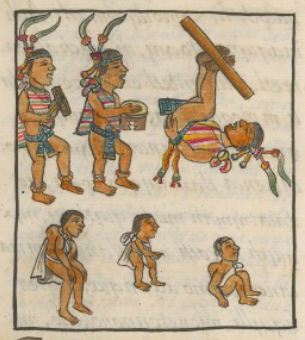tepotzotli (FCbk8f19v)
This iconographic example, featuring a person with an excessive curvature of the upper back, what used to be called a hunchback (tepotzotli). This is included in the digital collection for the purpose of making potential comparisons with related hieroglyphs. The term selected for this example comes from a word in the text (tepotzome, in the plural) that accompanies the image on this page. This example shows a standing male in profile, facing right. His body is bent slightly. His hands are on his knees. He wears a white loincloth and cloak, but the lump on his upper back protrudes from behind the cloak. His skin is a terracotta color.
Stephanie Wood
This disabled person was apparently kept around the ruler to amuse or entertain (!) him, if the text can be trusted. The contextualizing image shows another, smaller person with an excessive curvature on his upper back, too, and therefore the text provides the plural, tepotzome (or tepotzomeh, with the glottal stop). Hunched backs (a condition called kyphosis, in English) appear in some glyphs (see: examples for Cuauhtepotzo) perhaps as a phonetic indicator and probably not a condition suffered by eagles.
Stephanie Wood
tepotzome
1577
Jeff Haskett-Wood
disabled, alterabled, discapacitado, gibosos, corcobados
tepotzo(tli), a person with kyphosis, or the excessive curvature of the upper back, once called a hunchback, https://nahuatl.wired-humanities.org/content/tepotzotli
el corcobado
Stephanie Wood
Available at Digital Florentine Codex/Códice Florentino Digital, edited by Kim N. Richter and Alicia Maria Houtrouw, "Book 8: Kings and Lords", fol. 19v, Getty Research Institute, 2023. https://florentinecodex.getty.edu/en/book/8/folio/19v/images/f3843c90-31... Accessed 7 August 2025.
Images of the digitized Florentine Codex are made available under the following Creative Commons license: CC BY-NC-ND (Attribution-NonCommercial-NoDerivs 4.0 International). For print-publication quality photos, please contact the Biblioteca Medicea Laurenziana ([email protected]). The Library of Congress has also published this manuscript, using the images of the World Digital Library copy. “The Library of Congress is unaware of any copyright or other restrictions in the World Digital Library Collection. Absent any such restrictions, these materials are free to use and reuse.”






